Baroque Art Exam 2
1/48
There's no tags or description
Looks like no tags are added yet.
Name | Mastery | Learn | Test | Matching | Spaced |
|---|
No study sessions yet.
49 Terms
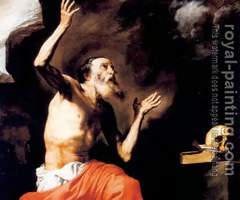
Jusepe de Ribera, St. Jerome with the Angel of Judgment (1630)
subject: within the Church of the Trinity in Naples, large scale, favorite subject of Ribera, St. Jerome being visited by the Angel of Judgment in the wilderness (symbol of penance, faith, rejection of materials)
form: very thin, red/white robes, see his books, devotion images, Bible, human skull representing inspiration and devotion in the idea that we all die, rock desk, harshness to all of it, barren landscape, rocky, dark clouds, emancipated, shocked by appearance in angel coming out of clouds, realistic portrayal of ribs, dirty rails, dramatic lighting, old man attributes, bright white light is image of divine, not static, off balance, kneeling, hears trumpet of last judgment by angel, very contrasted body, lot of light and dark with objects, Baroque dynamism and drama, partial nudity - can see self sacrifice, vulnerability, diagonal wings, harsh view of angel, not very flattering, very bright skin, more loose/painterly manner, more visible brush strokes, an auto-de-fe
function: represents devotion and being full of faith while searching for penance to be with God fully
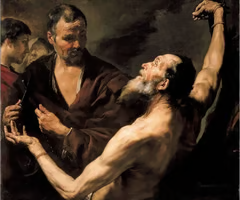
Jusepe de Ribera, Martyrdom of Saint Bartholomew (1630)
subject: realistic portrayal of torture, 3 by 3 ½ feet, St. Bart, executioner, and witnesses (makes viewer think about their action), St. Bart is one of the 12 apostles, Golden Legend says he was martyred in Armenia and was flayed alive
form: uses Caravaggio’s early style to put this in viewer’s space: threatening to fall out of picture plane, like you are a part of the scene, executioner is sharpening knife to cut skin off of body while he is tied to a tree (effort to turn him away from God), executioner is focused, has a mask, unaffected, coarse figure, sun burnt, grungy, stubble, dirty, rough hands, Bart’s hands are also dirty, nude, stretched painfully across picture plane, pull on muscles, sagging flesh, image of old man, faces heaven, turns toward divine light - very effective, bathing him in strength to persevere, mouth is open and begs question of what is he looking at, eyes and face are dramatic, very light paint, wrinkles, hair, soft beard, an auto-de-fe
function: shows the devotion to God that St. Bart had and how he paid the price physically with his body, self sacrifice
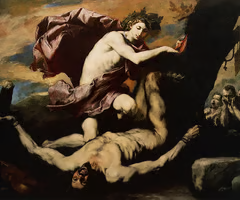
Jusepe de Ribera, Apollo Flaying Marsyas (1640)
subject: story from Metamorphoses, Apollo sees Marsyas (follower of Bacchus) is very good at the flute, he gets angry, challenges him, is declared winner by Muses, and flays him alive
form: more color in sky, took more inspo from Reni in many areas, wants a decorative classical style, contrast between horrific event and beautiful sky, beautiful Apollo (very Reni-like), flute hanging in tree in top right, gruesome because he is in act of pulling flesh away, other satyrs in anguish, details of Apollo are classical, powerful, very strong looking and calm, Marsyas (very Caravaggio-like) is in complete distress and has an incredibly realistic face of utter pain, body is very detailed and sprawled out on tree, intense contrast between the beautiful Apollo figure that shines above and the dark and pained Marsyas figure below surrounded by darkness
function: shows how we should not challenge the divine in any way

Jusepe de Ribera, Martyrdom of Saint Phillip (1640)
subject: 7 ½ by 7 ½, commissioned by King Philip IV of Spain (Patron saint), one of the apostles, golden legend says he preached in Turkey area, was stoned for teaching and then crucified,
form: not developed setting, but lots of witnesses (mothers, children, ordinary people), outstretched body across the picture plane, arms very stretched, twisted, eyes are pleading up to God, lot of muscular figures, bright and colorful palette, unique, differing emotional faces, extra loose skin on rib cage, age’s impact on the body, actually feeling the weight, feel like a part of the scene, immediacy, lot of diagonals, swooping motions, dynamism, towards heavens, baroque elements
function: frail old man being put to death for faith (public spectacle), lot of witnesses, show of devotion and faith

Jusepe de Ribera, Boy With a Club Foot (1640)
subject: 3 by 3 ft, child with a deformity, ragged, rough teeth, painted in Naples, commissioned by Flemish Art Dealer
form: holding crutch, big smile, illuminating face, bright eyes, monumental presence, right on picture plane, makes us look up to him, interesting contrast, appears to be a beggar, directly acting with audience, popular subject for Flemish, different portrayal from past, more heroic, holding a piece of paper, bright white, Latin writing, carrying the crutch like a rifle, scrunched up hat like a solider/ military, speaks to requirements for begging, permit, has a religious effect to it
function: the writing on the paper legitimizes the practice of begging and provides a message to viewers, not an ordinary beggar, is a messenger asking people to be charitable so they may receive salvation (good works) - really against Reformation thinking

Francisco de Zurbaran, St. Peter Nolasco's Vision of the Crucified St. Peter (1630)
subject: commissioned by Mercedarians (he is their patron), style inspired by Caravaggio and Velazquez, Spanish saint, worked in 13th century - difficult time where Spain was occupied by the Moors, North African Muslims, all driven out by this point, St. Peter’s mission was to rescue and provide relief to the captives/victims of the Moors treatment, 6 by 7 ft, St. Peter Nolasco had a vision of St. Peter being crucified as he was ready to leave his mission but he was then convinced to stay and continue his work there
form: tenebrism, huge contrast between light, dark, dramatic lighting, sobering effect, direct and engaging, bare background, help focus on subject, based off of engraving given to him, interpretation is a little awkward, St. Peter N shown in white habit, surprised reaction, but very quiet and restrained, figure appearing to flat, not great at space, used a real life model to figure out dimension, doesn’t hold weight, but still communicates idea, cloth is very realistic, face is also very good, peace
function: meant to show humility, devotion, orthodox thinking, prayer, immediacy, understandability, trying to boost his image of sainthood, documented,
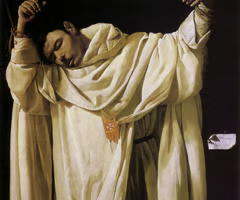
Francisco de Zurbaran, Saint Serapion (1630)
subject: Spanish saint who was connected to Order of Mercy, 4 by 3 ft, 3rd Crusade, martyred while preaching gospel to Muslims - died a gruesome death, but not apparent in this image
form: super immediate, dominates canvas, painted different from history because he wanted it to have a different mood, no suffering, just solemn feeling, hands are tied, big tree behind him, Caravaggio lighting, contrast of light and dark, divine light, softens death, contemplation, devotion, thought - not emotional, doing this for the order and church, robe is incredibly detailed, panic features, ordinary sense, symbolic representation instead of actual - sense of sacrifice, wears badge and white garb of the Order, red, gold, and white cross badge, peaceful death, slumped head underneath light, fool the eye illusion, paper tacked to the tree or canvas, illusionistic device - subject, artist date, confirms he wasn’t a full saint at this point, “Blessed Serapion, detailed hands, realistic movement, realistic sway of body
function: intended to be hung while dead monks would lay before being buried
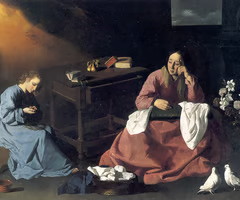
Francisco de Zurbaran, Virgin and Christ in the House of Nazareth (1630)
subject: 5 ft by 7 ft, no specific commission, Mary and Christ are sitting together working on individual things
form: lot of shadows, bright figures, vibrant, dark background, divine light upper left, supernatural presences peaking in through the light, slight fireplace, window, table, still life, space is weird, Mary is sewing white cloth - sacrifice/purity, mending, Mary’s colors, Mary is distracted, melancholy expression, crying slightly, Christ is sitting on a bench (simple home design), focused on his fingers, crown of thorns on his lap - symbolic, draws us to his sacrifice, sweet hair and face, very focused, blood from finger - awareness of future purpose, contemplative image, divine light over him, Mary also knows what’s going to happen, so she is very sad she will lose her son, pair of doves in corner, traditional white lilies and roses, images of love/purity with Mary, books on table, traditional with Mary (piety), Mary is displayed as a simple mother
function: desire for a focus on Mary, scene of humanizing Mary and Christ without Biblical references, promotes family life, means of connecting common people to religion
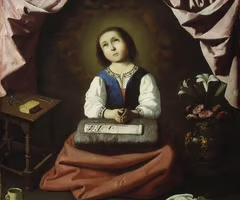
Francisco de Zurbaran, The Young Virgin Praying (1630)
subject: devotional image, unique subject, moment where Mary stopped working to pray to God (Golden Legend)
form: framing devices used, large pink and red drapery, elevated platform, curtains, industrious, sewing, embroidery, basket, beautiful vase with lilies and roses, her colors are evident - blue and red, blouse she wears is contemporary style, cup is from Seville area, eyes are big, head tilted towards heaven, little halo, cherubs looking towards her all around, awkward table, book, scissors, little flowers on table and in foreground, typical of Spanish still life, suggests meaning - blue flowers are fidelity and yellow are intelligence/maturity, basket is purity/productive
function: model of behavior for young girls, sought to connect religious images to everyday life, also sought to prove why she should be held up and focused on
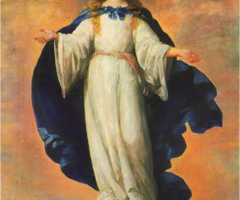
Francisco de Zurbaran, The Immaculate Conception (1660)
subject: frequent Spanish subject, celebration of Mary and role as mother of Christ - related to Spanish events, angel came and blessed old parents of Mary to have her as a child
form: Francisco Pacheco’s Art of Painting gave an outline for what ought to be included in representation of Mary, visible are a young woman who is wrapped in the sun, moon underneath, crown of 12 stars, hands should be meeting in prayer, wrapped in blue drapery, crescent moon - connection to purity - Artemis/Diana, angel heads hold her up, surrounded by divine bright light, sash with 3 knots, reference to Franciscans - big supporters of this as doctrine, represented poverty, chastity, and obedience, large on picture plane, tacked paper to front in bottom left, biblical verse represented
function: promotes her immaculate conception, needed to be born free of original sin and pure, wanted to promote this belief to official catholic doctrine (desire for images that show this)
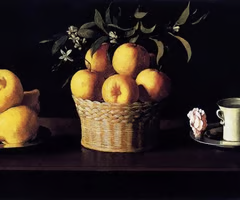
Francisco de Zurbaran, Still Life with Lemons, Oranges, and a Rose (1630)
subject: 3 ft by 5 ft, emerging subject, simple background with lemons on a plate, oranges in a basket, and a rose and cup on a plate
form: interest in objects, very accurate with texture, surfaces, and how light moves off it, black background, right on picture plane, sober, strong presence of light, intentional placement in space, bumpy lemons, polished silver, cup and rose together, orange blossom, oranges and lemons are wealthy, though not very symbolic here, basket is complex and realistic, each object as its own space and significance, not out of the ordinary, lemons and oranges have real weight, little flowers on orange leaves
function: supposed to hold them in reverence, discipline, calculated, symmetrical
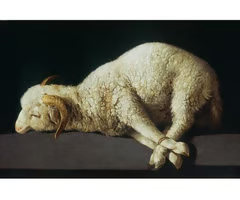
Francisco de Zurbaran, Agnus Dei (1640)
subject: “Lamb of God”, Christ is being symbolized through a lamb ready for the slaughter
form: little halo above head of lamb, lamb is bound, beautifully rendered, makes viewer sad, simple stone altar, ready for sacrifice, innocent, pure, white, soft eyes, texture is very beautiful, humble reference, many images of bound lambs created, inscription in Latin, “as a lamb” (Acts), bright white light, did not protest gave up its life
function: still life full of symbolism, Christ is seen as the sacrificial lamb who will die for all of our sins
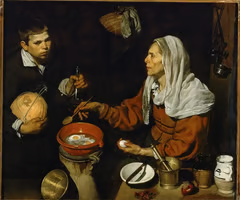
Diego Velazquez, Old Woman Cooking Eggs (1620)
subject: is a bodegones (image that combines genre scenes with heavy emphasis on still life), popular style in Netherlands and then in Spain, influenced by Caravaggio, old woman is making eggs with young man helping her
form: tenebrism, obscure background, immediacy, light bouncing off objects, textures of surfaces on inanimate objects are very good, put blemishes on objects to show realism, Seville cups, eggs are being cooked in a bright red pot, old hands, red and course, poised with a wooden spoon, lost in thought, quietude - reverence, viewing from above slightly, boy has gone to get her things and has come back, also distracted, beautiful basket, metal ladle, elevates the ordinary, really likes oval and circular forms, lot of lights and darks, shadows, reflections
function: aspects of Baroque - capturing a moment with regular people, contemporary life
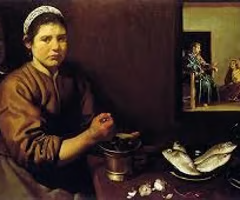
Diego Velazquez, Christ in the House of Martha and Mary (1620)
subject: religious painting, inventive nature, seems like genre but actually a religious subject in the background, bodegone, old woman and young woman cooking in a kitchen with image in background of Christ and Martha and Mary
form: table with arrangement of things like eggs, garlic, fish, grounding something, course hands, not sure whether image is a painting, mirror, window, front is contemporary, back is Christ’s time, northern style with Spanish spin, very realistic, soft warm light, Christ is seated, Mary is totally immersed, Martha is getting upset about doing work while she is sitting, Jesuit ideals represented in contemplative life (St. Ignatius Loyola, Spiritual Exercises) - Counter Reformation, texture is very interesting, old woman reminding younger to be contemplative and work - correcting her, very toned down colors, style of background is looser, foreground is very detailed and tighter
function: way to remember that both work and contemplating is necessary to a balanced life

Diego Velazquez, Los Borrachos (The Drinkers) (1630)
subject: unusual subject, large scale, elevated subject?, did this in Madrid, establishes with patron King of Spain Phillip IVth, royal commission hung in summer bedroom, Bacchus is hanging out with drinkers having fun
form: Bacchus is back, Caravaggio inspired, bright white body and face, crown of grape leaves, adorning a man with a leaved crown, among common men, not really divine besides a few references (partial nudity, helper behind), not surrounded by mythical group - but instead by course and scruffy people, can tell they’ve been drinking, different looks, facial movements, staring off, discussing, laughing, drinks all around, pots, jugs, foliage, leaves, Bacchus looks off into distance, dull background, interesting color scheme, interactive
function: Spanish court did not look upon drunks in a positive light, commissioned as a degradation of drinking, wanted to laugh at, make fun of, look down upon, other interpretation: emphasis placed on Bacchus, not very popular in Spain then, maybe making fun of pagan gods
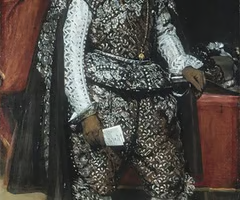
Diego Velazquez, Philip IV in Brown and Silver (1630)
subject: Philip IV of Spain - commissioner, royal portrait of King Philip IV in a brown and silver outfit as a King
form: freer brush technique, slight indication of detail in garment, loose, light, Rubens inspired, Italian inspired too, manipulates light well, more subtle color, extreme finery, not restrained style, embroidered, cloak, gloves, fancy hat, desk, little drape framing him, honoring kingly presence, looks out at us, not idealized, one hand is resting on sword, ready to attack, long face, mustache, bright red hair, other hand holds letter, shows his importance, signed by Velazquez which shows they are close to one another, still tight face look, precise stockings and shoes, very unique brush strokes and style
function: meant to promote sense of nobility, composure, power and quiet confidence
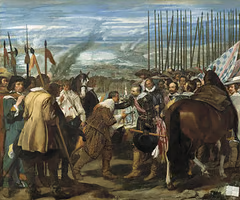
Diego Velazquez, Surrender at Breda (1630)
subject: larger than life, 10 ft by 12 ½ ft tall, Spain is on the right being led by Spinola - Spanish General and the Dutch are on the left led by Justin - Dutch Governor, Spanish just defeated Dutch and are meeting together to respectfully say good battle, made in Hall of Realms, Buen Retiro
form: lot happening in scene, very idealized, aggrandize event, Philip believed victories made them powerful, but benevolence made them great - moral supremacy, changes event, sense of equality, know who’s won and lost, Spanish are straight and tall, proud, Dutch are down, leaning, angled, disordered, battle effects in background of Dutch side with smoke, deep background with a city and lakes, meeting like diplomats, even ground, respectful, many characters looking at audience, more Spanish faces visible though, Philip got off horse, intentional action, shows goodness, interesting outfits, Philip in armor, paper tacked on corner, Justin bowing and extending key to city, Spinola still holding stuff, removed hat - respectful interchange, paints Spain in a very positive light, not historically accurate, but shows the trust between the groups, not static, moment in history, movements, subtle defeat and not showy
function: commission to commemorate victory of Spanish over Dutch, 1625 defeat, one of last great Spanish victories, still believed they were a world power, bring about good qualities of Spain (benevolent nature of Spain),

Diego Velazquez, Equestrian Portrait of Philip IV (1630)
subject: part of Hall of Realms in Buen Retiro, portrait of Philip IV on a horse
form: expanded landscape, loosely painted, foliage, clouds, plays with light, Philip is in command, not looking at viewer, sits tall and straight, feather hat, cool armor, staff of command one hand, reigns in the other, little bit of wind with cloak moving, position of horse is odd, speaks to his horsemanship, proud of horses, solid, but beautiful, raised up on back legs, maneuver by Spanish military, had to be strong to do this and to maintain posture, no over the top symbolic trappings, bright scene, focus on him and his abilities, no natural canopy, tacked on piece of paper in corner
function: shows command, control over animals and people, kingdom
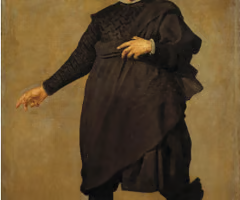
Diego Velazquez, Pablo de Valladolid (1630)
subject: jester of the court, served the king, shown striking a pose like the Spanish actors in a theater
form: used his personality and wit, detailed outfit and not funny looking, proud stance, looks noble and not like a typical jester, confidence radiating, stands believably, air surrounds him, creates an edge with the shadow - suggestion of space, depth is created by shadow falling, plain background, staring right at viewer, very nontraditional display in his clothes, character, and stance
function: not displayed as silly, but actually important looking, gives him a better representation than normal
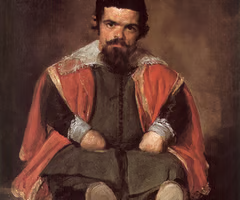
Diego Velazquez, Don Sebastian de Morra (1640)
subject: portrayal of a little person, jester of King Philip IV’s court, large image 2 by 3 ft
form: sensitive and caring representations of little people, popular subject for Velazquez, intelligence and dignity shown, hung in the Hall of Realms in palace, dressed well, bright red clothing, dark green outfit, positive image, monumental important presence, intense gaze, don’t get feeble minded feel, bright light on forehead, shows brow and thinking look, balled up fists, maybe angry or frustrated, dark brown hair, beard, mustache, nothing in background, nothing to distract, simple setting and pose, all about his presence, truly occupies the space, creates air between figure and background
function: shows them as individuals, no idealizing, allows their personhood to show
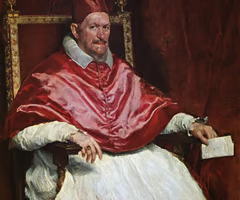
Diego Velazquez, Innocent X (1655)
subject: classic representation of a pope, Pope Innocent X posing for a portrait he requested be done for him
form: beautiful drapery, very shiny, white cloth is very beautiful and detailed, face is thoughtful, staring at viewer, very serious, lot of red and white, traditional colors, sitting on a royal chair, just like Raphael, looks irritable, Papal insignia, loosely painted, manipulates color really well, complicated cloth, gold rimmed chair, very detailed, hard to separate all the reds, kept him from blending in, uses shadows incredibly; color harmony and balance, immediacy and serious portrait focus, holds a note in left hand, identifies Velazquez’ signature and air of importance/connection, honor position, hand is slightly blurred to show movement, closer you go, the more blurry it gets
function: shows the character and real life characteristics of Pope Innocent X
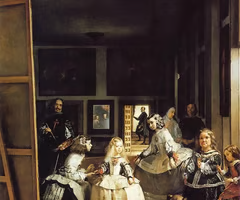
Diego Velazquez, Las Meninas (The Maids) (1655)
subject: monumental painting, 10 ½ by 9 ft, complex in subject, self portrait, group, and genre scene of everyday life in the royal court, seems to be a moment in their lives, not posed at all
form: figure in center is daughter, only living heir at the time, attended by maids, court dwarfs, dog, and other members of the court - nun chaperone, bodyguard, queen’s chamberlain, people are slightly blurred to show movement, very close to picture plane, dog is sleeping, everyone’s attention is drawn in direction that princess is looking, lot of interactions, something they need to react to outside of frame, king and queen seen in the reflection of the mirror on the back wall - this is who the rest of them were looking at, lot of complexity in movement and poses, reaching, bowing, stopped in motion, lot of light sources, front, back, and side, portrait is placed in Velazquez’ studio where he is working on a huge painting, they have come to see him, everyone to engage - says a lot about position in court, prestigious order of knighthood, reflects interest, paintings on back wall are mythological subjects painted by Rubens, divine participation in the arts, painting a subject of importance, brushes and pallets, maul stick, steadies his hand - heavy focus on him as a painter, dressed as a court officiant with keys
function: shows the status of Velazquez and the connections that he has with the royal family on a day to day basis, identifies painting as a liberal art - elevates the status of the artist, seen as craftsmen and not intellectual in the past
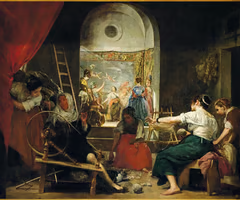
Diego Velazquez, Las Hilanderas (The Spinners) (1655)
subject: unusual piece, inventive and complex, contemporary women who are spinning wool, scene of everyday life for women, elevates status
form: centered in Triumphal arch, scene in background cove area, woman with helmet (Athena), represents fable of Arachne - she challenged Athena has the best weaver, they had a contest, Athena won and turned Arachne into a spider for eternity, mirroring of figures, shows equality, beautiful bright white skin, sun kissed face, bright red drapery and clothes, blues, major tapestries in the back, aspects of movement, wheel is blurry, working hands with thread, fast moving, precise foreground, loose background, ladder is symbol of progressing upward, illuminated and in between both scenes, divine light coming in with a direct diagonal to Arachne and Athena, tapestry being created is in Philip IV’s collection, Rape of Europa by Titian, painted for Philip 2nd, was knighted too, Arachne and Titian are being paralleled, good enough to be in competition with the gods, meant for an intellectual, only so many can understand complexity, speaks to great accomplishments by weavers, low level, human activity, barefoot, casual
function: addresses status of painting and social position - liberal art, don’t challenge the gods (Athena and Arachne), humans can compete with the gods
a way for us to become more sensitive to God's action in our lives, discover our deepest desires, make decisions from a place of inner freedom, and join our lives with the mission of Jesus
St. Ignatius Loyola, Spiritual Exercises (1522-24)
act of faith
Auto-da-fe
an art requiring decorum, historical accuracy, and intellectual rigor to serve religious and moral purposes, advocating for painters' higher social status and providing extensive iconographical standards for sacred art
Francisco Pacheco, Art of Painting (1649)
in Spanish art, it refers to a still life displaying pantry items such as victuals, game, and drink, often arranged on a simple stone slab, and also a painting with one or more figures, but significant still life elements, typically set in a kitchen or tavern. It also refers to low-life or every day objects, which can be painted with flowers, fruits, or other objects to display the painter's mastery
Bodegones
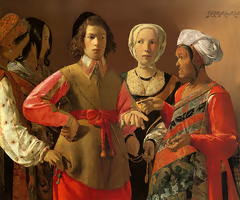
Georges de la Tour, The Fortune Teller (1630)
subject: genre scene, connection to Caravaggio - introduced subject, young man having his fortune being read, but actually being tricked by fortune teller and a group of women
form: ¾ length figures, simple background, sense of immediacy, lot of patterns, not accurate to the times, women are dressed fancifully, elaborate designs and patterns, signature above in corner illuminated, lot of reds, blues, pinks, and oranges, materials and textures are really good, confidence of man, sidelong glances, great facial expressions of the women all grabbing different things to steal from him, humorous, wrinkles, serious face of them, pale faces, tanned faces, dark and light hair, shiny
function: wanted to show off his abilities early in career

Georges de la Tour, The Flea Catcher (1630)
subject: unusual subject in France but popular in Dutch republic, large scale painting, a woman catching flees before going to bed
form: warm light, lot of shadows, very solemn, realistically sitting, reverence in figure, quietude, monumental presence, immediacy, very focused, night scene, nocturn, dramatic lighting, contrast is quite soft and subtle, incorporates light source as a burning candle, thinks about impact of light on surfaces, how light dissolves detail, very realistic, solid figure, not detailed skin, face is simple
function: show how light distorts and covers up details depending on the darkness of the area
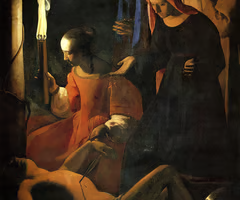
Georges de la Tour, St. Sebastian Tended by Irene (1630)
subject: night scene, religious painting, new kind of subject, soldier in Rome who sympathized with Christians so killed for it (tied to tree and shot with arrows), Irene found St. Sebastian and stops to help him
form: contrast of light and dark, quiet mood for meditation, rib cage is prominent, clothing is soft, figures aren’t very detailed, not about pain of Sebastian, but act of Irene, right on picture plane, light brings attention to Irene and her followers, caring expression on face, quiet look of sadness, prayer, tree looks like a marble column, diagonal arrangement of women that draws attention down to Sebastian
function: play with effects of light, internal source of it, charity and acts of mercy emphasized
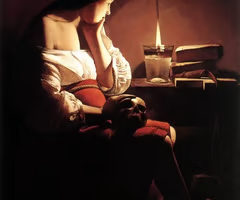
Georges de la Tour, The Repentant Magdalen (1640)
subject: Mary Magdalene is in a state of penance, meditating on her past sins and asking God for forgiveness, night scene, religious subject but very humanized
form: repenting for sins, rope on table used to punish oneself for sin, was a prostitute before she came to Christ, immediate, monumental presence, interior light source, focused on it, oil lamp, smoke, warm light impacting all objects, simple cross, prayer books, skull on lap with hand over it - contemplating death and morality, thinking about spirit, light represents presence of the divine, mesmerizing - light of God, powerful image, salvation through prayer and penance
function: counter to the Reformation pushing against penance as a sacrament, also enforces Mary Magdalene’s importance as a Bible figure
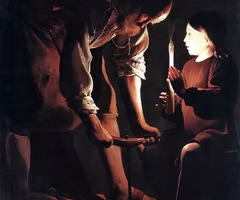
Georges de la Tour, St. Joseph the Carpenter (1640)
subject: nocturn, religious, interior light source, childhood moment of Christ
form: communicates sense of caring father, provider, educator, inventive subject, was not given much focus before, normally pushed to the side but here receives a lot of focus and emphasis since he is Christ’s earthly father - raises Him to be a good man, St. Theresa and her convent encouraged his importance, doing carpentry, Christ also was a carpenter, teaching Him in that moment, light illuminates Christ’s face, sweet interaction, immediacy, wrinkles on forehead, lot of carpentry images, not a lot of religious imagery, night scene, light goes off the skin incredibly well, 2 light sources - candlelight and the divine light on Christ’s face, dressed similarly, holes in apron, sandals, simple life but one of good upbringing and love, simple dark background, probably making a cross - foreshadowing Christ’s death
function: wanted to paint an image that is relatable to the masses, sense of connection and responsibility, eyes are engaged,
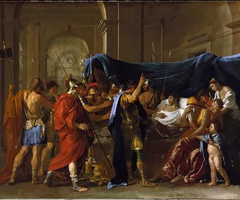
Nicolas Poussin, The Death of Germanicus (1630)
subject: first major history painting, patroned by Barberini family for private home, noble and heroic subject in Roman history, inventive, Germanicus (as Tacitus wrote) was a Roman general who was murdered by poisoning
form: image of sadness and suffering, heroic manner, surrounded by soldiers and family, pronounced figure pointing upward, probably yelling about revenge, range of emotions, controlled, same sad expression, red eyes, careful ordering, holding their lances and armor in place, set scene accurately to Roman society, architecture and columns + round arches, anger on one side with family in tears on the other, off to the right, faming elements, open space, dressed in white - purity and innocence, blue drapery behind, looks frail, gesture and looking at his soldiers while pointing to family demanding that they protect them, frieze like composition, moves left to right, figures are idealized, muscular, anatomically strong, marble architecture, not decorative, likes to rely on bold primary colors, reds, blues, yellows,
function: meant for only the educated to know and understand, a controlled scene of emotion and order, meant to display the heroic nature of Germanicus
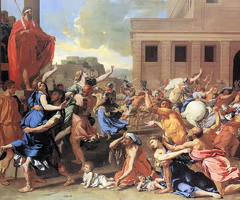
Nicolas Poussin, Rape of the Sabine Women (1640)
subject: patron is a French ambassador to Rome, based on the writings of Plutarch, associated with Romulus, Rome needed to produce children, so they invited Sabine citizens over for a festival and then kidnapped all of the women to build up the empire
form: lot of dramatic movements, pastels, deep red, blues, children on ground, women are all similar - same reaching motion, struggling face and body, men in same stances trying to control, starts as frieze, but slowly goes away, short diagonals, Romulus is pulling up cloak, creates a foreground, middle ground, and a background with figures and architecture, chaos of battle, idealized figures, gold body armor, young and old people, very energetic struggle, choreographed element to it, columns, marble everywhere
function: show the actions of the Romans not as lustful or senseless, but a necessary action to founding Rome
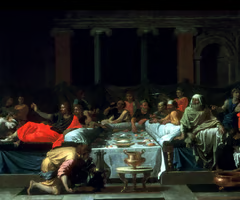
Nicolas Poussin, The Seven Sacraments, Penance (1650)
subject: patron is Cassiano de Pozzo and later Chantelou, washing of the feet, narrative story, told in Gospel of Luke, feast in the House of Simon
form: roman columns, huge, ionic, some are circular, cut off background with drapery, dark background, lot of activity in foreground, wine, food, servants, busy, talking, bright reds, golds, and blues, Christ and Simon are separated - symmetry, also background, Roman dining room, story with Mary Magdalene, brought oil and wept at Christ’s feet, Christ in a blessing motion to Mary Magdalene - freely washing His feet, interactions all around the painting, lot of private discussions, idealized figure types
function: Counter-Reformation symbol, shows validity of this sacrament and how Christ participated in it, also shows importance of Mary Magdalene
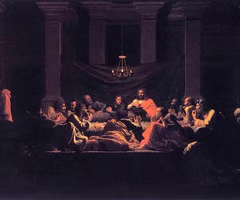
Nicolas Poussin, The Seven Sacraments, Eucharist (1650)
subject: patron is Cassiano de Pozzo and later Chantelou, takes story of Last Supper as source and makes it a historical painting, night scene with a sacred element, unique portrayal, Christ is blessing the food and announcing his betrayer
form: early Roman empire, columns, clothing, colors, styles, serious, not decorative, monumental columns (pilasters), drapery behind to focus attention on subject, lounging individuals, reclining and eating, warm light reflecting on people’s clothes and bodies, people have sadden faces, horror, confused, barefoot, foreshortening of bodies. Judas appears to get up and leave, exiting the scene, chandelier is presenting a light source, believable portrayal of situation, controlled
function: meant for the intellectual, Counter-Reformation symbol
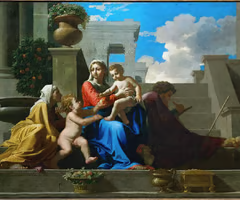
Nicolas Poussin, Holy Family on the Steps (1650)
subject: image of Mary, Joseph, Elizabeth, St. John the Baptist, and Jesus (the latter are children), patron is a part of French royal court, placed at the Temple of Jerusalem
form: Roman background, multiple light sources, bright and noticeable primary colors, triangular form, stable, religious shape (trinity), lot of geometric forms, columns, stairs, Corinthian capitals, vast structures, realistic to Roman times, center of Jewish worship, significant placement, stairway to heaven, ascension, Mary is the vehicle as Mother of Christ and as a heroic stance, nobility, confidence, upright, central apex of pyramid, Elizabeth on one side, Joseph on the other, John and Christ interacting - symbolic significance of an apple, goes back to Adam and Eve story, Joseph in the dark, somewhat unaware of what is happening, holding a stone slab and a t square - man of learning and intellect, not just a carpenter, still life elements reference to three magi and gifts, submitting authority to the church, no halo, but set apart by little arch framing device, light on the women and children
function: emphasizes an intellectual conversation, reminds us of the first sin and need for a savior - Christ is the New Adam and Mary is New Eve, parallel between OT and NT,
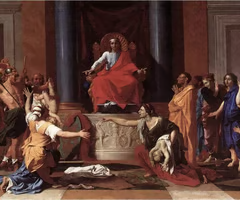
Nicolas Poussin, Judgment of Solomon (1650)
subject: story of Solomon judging the case of the two women claiming to be the mother of the baby
form: Solomon embodies wisdom - intellectual subject, story where he makes a judgment on who is the true mother of the baby - says to cut it in half, but true mother says to just give the baby to the other woman so it wouldn’t die, very dynamic display, baby hanging in air, other being held upside down in arms of “fake” mother, classic Baroque elements, balance, symmetry, controlled, columns, elevated throne, drapery, big architecture, anger on one face but pleading on the other, illumination, colors, red, blues, yellows, soldier looks strong, simple gesture by Solomon, marble and colored columns, both square and circular, used to have a more complex background but decided to make it simpler for audience, sketch had baby as more of a focus, now it is focused on Solomon and women, scaled down Solomon and elevated him, less immediacy in final, regarded as an OT type for Christ, prefiguration as Christ’s role as judge
function: intellectual story showing intellect of Solomon and how he foreshadowed Christ’s role as the judge
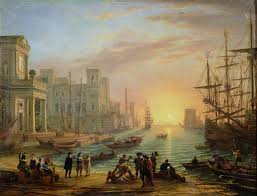
Claude Lorrain, Seaport at Sunset (1640)
subject: somewhat large painting, imaginative portrayal of ideal landscape setting, realistic but not real, inventive location but suggests it is accurate, seaport town at the end of a day
form: nice harbor in a robust town/city, broad buildings, important, large, busy, good ships in harbor, small people boats, hustle and bustle of energetic port, emphasis is on the sun, trying to capture effects of the sun, nothing harsh or overwhelming, figures are small, here to animate but not the focus, create a sense of humans and nature in a harmonious relationship, water and light hitting the surface is really good, ripples of water, low sun, sparkling intensity, objects close are dissolving, good reflection that captures the power of the sun, warmth, color changes in sky, blues, reds, purples, invited past foreground to sun as the focus, not vanishing point, but pulled back at a diagonal, framing devices: buildings, ships, etc.
function: trying to capture effects of a specific time of day, how light in different times of day affects areas, image of order and completeness
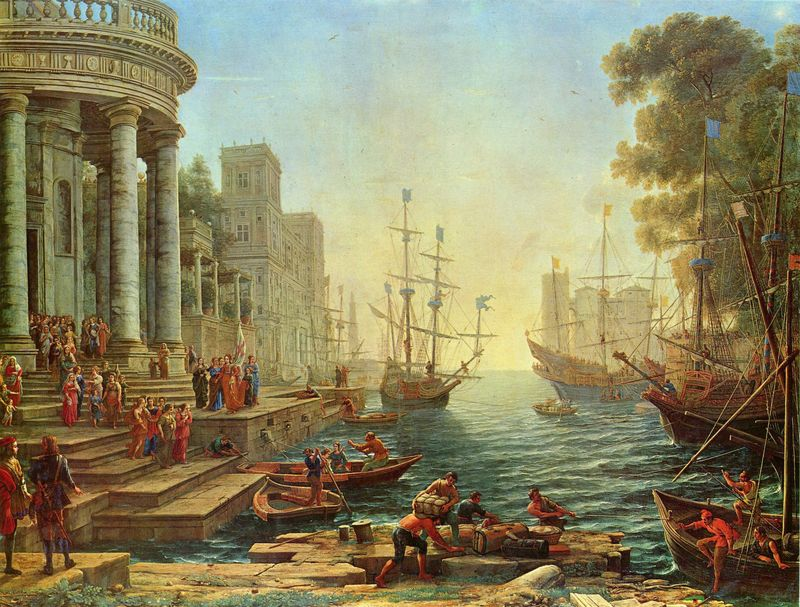
Claude Lorrain, Embarkation of St. Ursula (1640)
subject: ideal setting of a biblical story, somewhat large painting, St Ursula is a British princess (4th cent. who set sail for Rome on a pilgrimage with lots of virgins but was massacred by Barbarians, all became martyrs) - told by Golden Legend
form: framing devices: buildings, ships, etc, can’t seethe sun but know that it’s the focus, effects on sky and water, sun is rising, scene set in the morning as a start to a journey, buildings are Roman inspired, large columns, windows, circular and rectangular forms, towers in back are faded, ships are still visible but faded because of the bright sun, scene of them on ships getting ready to travel, she has a Christian flag in hand, workers everywhere helping out, trees and foliage hit by light, could care less about historical accuracy, just wanted idealic scene, recognizable buildings from 17th c. Rome and 15th c. Medici Palace, accurate but not historically true to her time, similar story with the ships displayed
function: combine history painting with landscape

Claude Lorrain, Landscape with the Marriage of Isaac and Rebecca (1650)
subject: story from genesis, inscription identifies the scene - nothing suggests any religious theme other than title, different interpretation of subject, patron is a cardinal related to Innocent X, 5 ft by 6 ft
form: landscape, idealic and beautifully perfect, people dancing, celebratory, country wedding setting, explore effects of sunlight on water and foliage, know sun is there and how it effects the land, mill and water well, the way water moves with light, pulled in and around the background, complexity of shadows and patched of light, cows, large trees, shepherd, balanced between humans and nature, belonged to a pair - pendent paintings, midday portrayal, shadows are long, sun is just starting to descend
function: suggests it is an elevated subject combined with religious
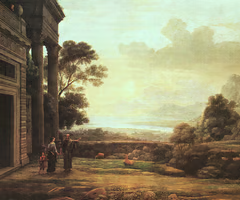
Claude Lorrain, The Expulsion of Hagar (1670)
subject: pendent painting with Hagar and Ishmael in desert, Hagar is a servant of Sarah - Abraham’s wife, they could not conceive so she told Abraham to be with Hagar, then Sarah was with Abraham and both had boys, Sarah got jealous and has Abraham expel her
form: early part of the story, sends them out into desert with bread and water, buildings are not accurate at all, wonderful Roman structures with large columns and marble features, Sarah or Isaac looking down, beautiful huge wilderness, doesn’t seem scary though, big lake, mountains, framing devices, sunny, very hazy sun and how the sun reflects light everywhere
function: show the landscape of this story and what the scene could have looked like, how light affects a great landscape
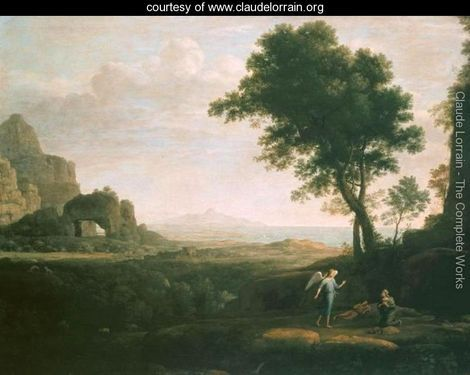
Claude Lorrain, Hagar and Ishmael in the Desert (1670)
subject: pendent painting with The Expulsion of Hagar, Hagar and Ishmael have been wandering around in the wilderness, run low on resources, Ishmael gets sick and Hagar starts to cry, angel appears and helps them by directing attention to large lake of water
form: nice body of water visible in background, a bit unbelievable considering OT story, sense of divine light with angel, rocky structures, mountains, expansive, long shadows, ray of light, foliage and how late day light affects it
function: show the landscape of this story and what the scene could have looked like, how light affects a great landscape
scholar that has comprehensive philosophical and theological works, particularly the Summa Theologica, which synthesized Christian theology with Aristotelian philosophy
St. Thomas Aquinas
Antiquarian, historical science person, worked for cardinals, helped Poussin draw commissions.
Cassiano del Pozzo
Italian Catholic Cardinal. The nephew of Pope Urban VIII, he benefited immensely from the nepotism practiced by his uncle
Cardinal Francesco Barberini
Greek biographer of the first to early second century AD. Author of Parallel Lives which compared famous men of classical Greece and republican Rome.
Plutarch
A Roman historian who presented the facts accurately. He wrote about the good and the bad of imperial Rome in his Annals and Histories.
Tacitus
French collector and patron of the arts. He encouraged major artists of his era, in particular Nicolas Poussin and Gian Lorenzo Bernini, and is known for his diary describing Bernini's visit to Paris
Chantelou